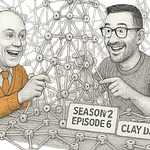The Confession We Needed to Make
I had to admit something on today's livestream that's been gnawing at us for months: We're really fucking good at vertical SaaS, but when it comes to horizontal plays? "Go with God," as Jordan likes to say.
We can nail pain-based segmentation all day long for construction software or legal tech. We can craft Permissionless Value Props that make prospects weep with joy. But take that same methodology to a horizontal business model, and suddenly we're the marketing equivalent of a Ferrari trying to tow a boat; technically possible, but definitely not what we were built for.
Enter Kellen Casebeer from The Deal Lab, who showed up on our livestream today with a methodology so complementary to ours that it felt like finding the missing piece of a puzzle we didn't even know was incomplete.
Why This Matters (And Why We're Not Embarrassed to Admit Our Limits)
Here's the thing about the Cannonball GTM methodology: it's surgical. When you have a vertical market with specific, identifiable pain points, we can build campaigns that convert at rates that make CMOs question whether their analytics are accurate.
But horizontal SaaS? That's where traditional market segmentation begins to resemble demographic convenience rather than pain-based precision. And honestly, that's where most marketers get stuck, trying to be everything to everyone, aiming at average and hitting nothing.
Kellen's approach doesn't just complement ours; it systematizes the exact process we've been improvising for horizontal plays.
The Market → Segment → Persona → Angle Waterfall
Kellen's methodology is deceptively simple, which is exactly why it works. Think of it as a strategic waterfall that forces pattern interrupt at every level:
Market: The Familiar Clusters
Start with what everyone knows and recognizes: the filters in ZoomInfo, the LinkedIn categories, the "I work in financial services" identifiers. These aren't your end goal; they're your anchor point (note, as Kellen and I described later in the show, ZoomInfo and LinkedIn are your lowest common denominators - we’re not recommending them - in fact, Kellen’s model, very much like ours, depends on unique data sets, typically centered in Clay).
Segment: The Meaningful Subdivisions
Here's where the magic starts. Instead of attacking "financial services" with generic messaging, you divide by what meaningfully changes how you communicate:
Product-led growth vs. sales-led growth companies
Pre-revenue vs. post-product-market fit startups
Companies using specific tech stacks
Organizations with particular growth challenges
The key insight: Segmentation isn't about objective demographics—it's about creating meaningful communication differences.
Persona: Context-Dependent Roles
A CMO at a product-led growth company and a CMO at a sales-led growth company are completely different people. Different metrics, different tools, different unit economics, different everything.
The persona isn't just the title, it's the title in the context of the segment in the context of the market.
Angle: Your Directional Argument
This is where Kellen's thinking gets surgical. He doesn't think about "pain points" (which the market experiences) but "angles" (which you control).
An angle is your suggestion, your argument, your directional approach to why this specific persona in this specific segment should care about what you're saying right now.
The Clinical Trial Philosophy (Or: Why Being Wrong Is Actually Winning)
Here's where Kellen blew my mind with a healthcare analogy that's so good I'm stealing it forever:
"We run clinical trials. Testing is god. The truth comes from market feedback, not from what we think."
In cancer research, you don't get attached to specific drug combinations. You design clean, segmented tests that give you truth. If a formulation doesn't work, that's not failure—that's data.
Same principle here:
Map out your market/segment/persona/angle combinations
Run clean tests (Kellen typically uses 3,000 contacts split five ways)
Measure outcomes without ego
Use results to iterate on the entire framework, not just copy tweaks
The goal isn't successful campaigns because campaigns are just diagnostics. The goal is repeatable input behaviors that generate predictable outputs.
Where Cannonball GTM and The Deal Lab Methodology Intersect
After watching Kellen work through his framework, the overlap with our approach became crystal clear:
What we share:
Obsession with testing and iteration over theoretical perfection
Rejection of "spray and pray" demographic targeting
Focus on creating messages that create pattern interrupt
Understanding that one-size-fits-all messaging converts at zero
Where we diverge (and complement each other):
Cannonball GTM: Surgical pain identification through vertical market intelligence
Deal Lab Method: Systematic message testing across horizontal market segments
Cannonball GTM: PVPs that prospects would pay to receive
Deal Lab Method: Angles that create identity ownership and avoid landmines
Cannonball GTM: AI-enhanced data analysis for market intelligence
Deal Lab Method: Clay-powered market mapping for rapid segmentation testing
A Smidge on The Shovels Database - The Example That Made it All Click
When Kellen walked through how he'd market the Shovels database to electricians, the methodology came alive:
Market: Trades
Segment: Electricians (vs. HVAC, general contractors)
Persona: Sales lead at electrical contractor
Angle: "Early access to Tesla charger permits before competition"
The message: "Hey Doug, did you know that in 94523 (Pleasant Hill, CA), 874 houses pulled solar permits in the last 60 days? Seventy percent of those permits were pulled by homeowners who haven't hired their electrician yet. If you reached out before they go to market, an attractive offer could help you close quickly before getting into a competitive situation. Can I show you how Shovels data can help you do this every day?"
That's a pain-qualified segment message. It works because it's the right angle, to the right persona, in the right segment, backed by real data.
What This Means for Cannonballers
If you're working with vertical SaaS, keep using our methodology, it's built for exactly that problem.
But if you're tackling horizontal markets, or if you want to systematize your message testing beyond our current approach, Kellen's framework gives you:
A systematic way to think about market division that goes beyond demographics
A testing methodology that treats campaigns as experiments, not campaigns
A scalable approach to rapid iteration without getting precious about any single message
A framework for horizontal plays that creates the same precision we get with vertical markets
The Bottom Line (Because This Is Getting Long)
We've been saying for months that the companies winning in the AI age are the ones that systematize what others leave to chance.
Kellen's methodology does exactly that for message-to-market fit testing. It's not magic, it's systematic, it's testable, and it's scalable.
And frankly, it makes us better at what we do.
Jordan's back next week to dive deep into the Shovels MCP server integration. We'll show you exactly how to combine Kellen's systematic market mapping with our AI-enhanced data analysis for campaigns that convert.
Until then, start thinking about your markets not as demographics, but as meaningful subdivisions that change how you communicate.
P.S. Kellen's having a baby in August. We asked what gifts to send, and he said "invest in the S&P 500 and email me in 20 years to thank me for not taking your stupid gift." This is why we like this guy.
Miss our livestreams? We're live every Friday at 9 AM PST on LinkedIn. Come for the methodology, stay for the dad jokes and occasional existential crisis about marketing theory.












Share this post